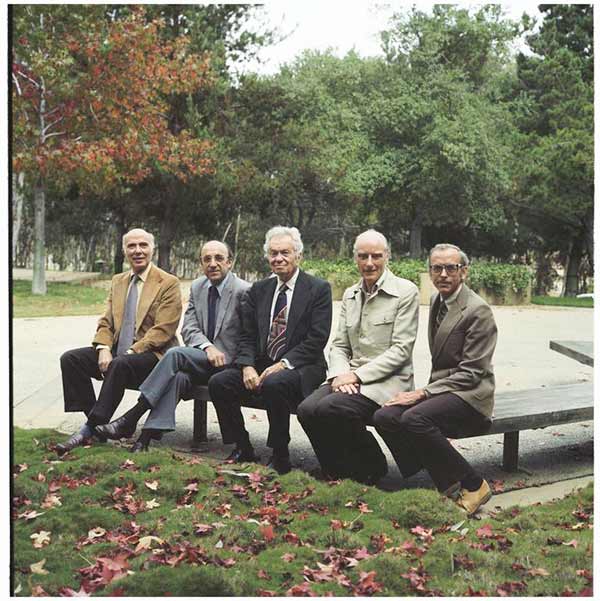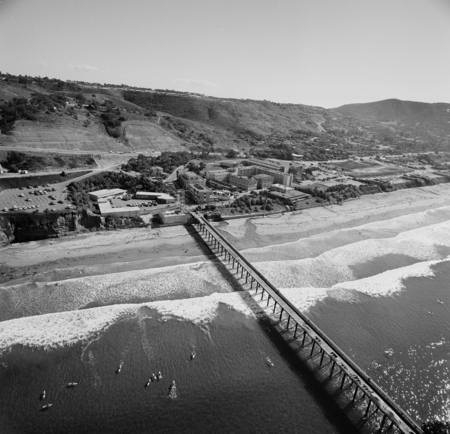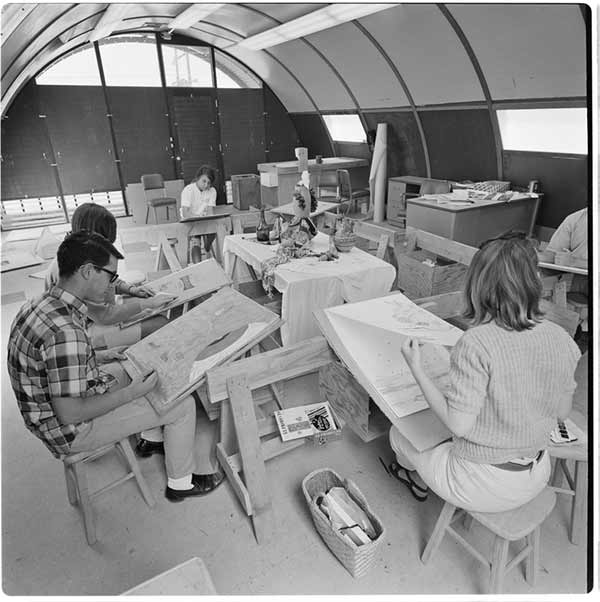
By:
- Erika Johnson
Published Date
By:
- Erika Johnson
Share This:

All students, faculty and staff are invited to celebrate UC San Diego Founders Day, which will include free Nomad Donuts, giveaways, music and a photo booth.
A University is Born
Join us as we celebrate UC San Diego’s 58th birthday
In 1960, UC San Diego’s first students—graduate students in physics, chemistry and earth sciences—enrolled in a brand new University of California campus. Four years later, the first undergraduate students arrived. Many were attracted by the chance to study with renowned faculty members, such as Harold Urey, a Nobel Prize laureate who arrived in La Jolla in 1958 to teach chemistry. At an assembly for new freshmen, Urey counseled the precocious students: organize your work carefully, and you may be able to “get by” with 60 to 70 hours of study a week.

Students were drawn to the new UC San Diego campus for the chance to work with renowned faculty members, including Nobel Prize laureates (left to right) Renato Dulbecco, Roger Guillemin, Harold Urey, Francis Crick and Robert Holley, pictured here circa 1977. (Robert Glasheen Photograph Collection, Special Collections and Archives.)
“[UC San Diego] is a challenging new school not bogged down by tradition with a curriculum of innovation and a look to the future,” freshman Mike Wagner told the San Diego Union-Tribune in 1964. Treated like graduate students, freshmen could select from majors in biology, chemistry, earth sciences, English, math, philosophy and physics.
From the very beginning, UC San Diego was designed to be different. The university was officially established on Nov. 18, 1960. Since that time, it has maintained a spirit of curiosity and a desire to look deeper. Our scholars continue to make a difference in unconventional ways, such as turning oil rigs into living reefs; addressing critical human rights issues through the arts; creating personalized cancer vaccines and developing solar-powered water irrigation systems to help end hunger.
In honor of our campus’s 58th birthday, all students, staff, faculty and alumni are invited to join in Founders Day Celebration from noon to 1:30 p.m. on Friday, Nov. 16 on Library Walk. The free party will include donuts, music, a photo booth, giveaways and more.
Romanced by the sea
It was the winter of 1957, and Roger Revelle, director of Scripps Institution of Oceanography, was planning an unforgettable beachside reception for the University of California Regents. He was intent on convincing the Regents to approve a new university campus in La Jolla. The trip included visits to three potential sites, including an area around Lake Murray, the northeast corner of Balboa Park and the land north of Scripps Institution of Oceanography. Among the criteria were “a sense of place” and “the spirit and nobility” of the site.

Scripps Institution of Oceanography was founded in 1903 and became part of UC San Diego in 1960. Director Roger Revelle would walk on the beach with potential university recruits, persuading them with his vision and the panoramic ocean views. (Aerial view, 1967, SIO Photographic Laboratory Photographs.)
Two years later, the new campus was endorsed by the Regents, to be named the University of California, La Jolla. Scripps Oceanography, already a prominent research institute with hundreds of graduate students, would anchor the burgeoning university. The next step: recruiting prestigious faculty members.
Again, Revelle looked to the sea for inspiration. In his recollections of his first years at UC San Diego, the late Keith Brueckner—founding chair of the Department of Physics—explained how he was moved by Revelle’s vision on a walk to the beach. “Revelle told me in much detail of the wonderful plans he and the university had proposed for the new campus. Late in the afternoon Revelle walked with me from the mesa top down a steep path leading to the ocean to see the quite spectacular beaches with impressive surf…by the end of the day I was convinced of the feasibility of Revelle’s plans and had tentatively indicated my acceptance of his offer.”
For Giovanni Chimienti, a postdoctoral fellow, it was a shock to transition from 10-degree Connecticut weather to 80-degree sunshine in La Jolla. It was January 1968 when he began working in the Department of Neurosciences at the newly established School of Medicine. Because the school had yet to be built, his offices were located at Scripps. “The outdoor life was quite a surprise,” said Chimienti. “At lunch time, everyone got into swim suits. The men’s bathroom was full of surfboards. I called them ‘surf specialists.’”
The first students united at the beach as well. They would spend time at a small beach house next to the Scripps pier. Their unofficial mascot was “Hot Curl,” a famous surfing cartoon character created in 1963. It wasn’t until Dec. 12, 1964 that the inaugural class voted to be known officially as UC San Diego Tritons, named for a mythical god of the sea. Other “nicknames” for the campus that were considered included Dolphins, Barracudas, Grizzly Bears and Hornets. Ultimately, the sea god won, inspiring other traditions such as the Triton Fanfare, a ceremonial horn blowing using conch shells.
A grand experiment

In 1962, President John F. Kennedy signed a bill that transferred 436 acres of Camp Matthews to the University of California for the San Diego campus. Quonset huts, leftover from the Marine base, served as classrooms before the first academic facilities were constructed. (Harry Crosby Photographs, 1966, Special Collections and Archives.)
In just six decades, UC San Diego has grown tremendously. What started as a campus comprised of a small number of graduate students in 1960, and a freshman class of 181 in 1964, has multiplied to 30,285 undergraduates and 8,513 graduate and professional students today.
For the second year in a row, the London-based Times Higher Education ranked UC San Diego the world’s No. 1 research university founded during the “golden age” of higher education development, in the two decades between 1945 and 1967—when higher education was characterized by rapid university expansion and increasing investment in research.
Roger Showley’s words to his peers in the graduation issue of Triton Times in 1968 still ring true today: “In a sense, [UC San Diego] has become a model for the new colleges and universities across the country. Here, there are no established traditions to hamper new ideas. There are no serious barriers to impede relations between students and faculty.”
Share This:
You May Also Like
Stay in the Know
Keep up with all the latest from UC San Diego. Subscribe to the newsletter today.


